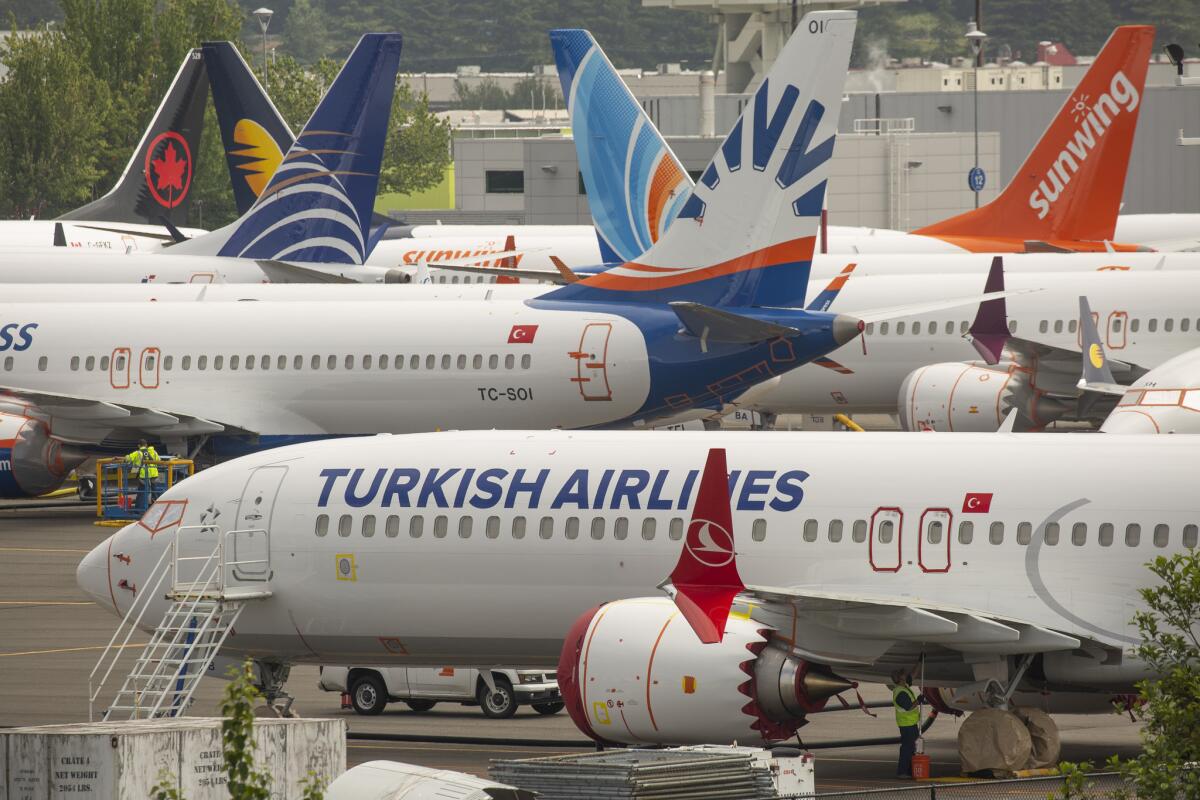FAA starts Boeing 737 Max test flights, key to returning planes to service after deadly crashes

- Share via
Boeing Co. and the U.S. Federal Aviation Administration began a series of long-awaited flights to test whether the revamped 737 Max is safe following two deadly crashes, and investors cheered the rare good news for a planemaker mired in crisis.
A Max 7 flight-test aircraft concluded the first of three planned days of testing, landing at Boeing Field at about 2:16 p.m. local time Monday, with an FAA pilot sharing the controls with a crew member from the company. Flight enthusiasts around the world followed in real time as the aircraft flew over central Washington and performed maneuvers such as stalls, based on airspeed and altitude data on FlightRadar24.
The so-called certification flight is a milestone toward ending a grounding imposed worldwide in March 2019 after the two crashes of Boeing’s best-selling model killed 346 people. The FAA plans to put the jet, bristling with monitoring equipment, through a rigorous examination, said a person familiar with the matter, who wasn’t authorized to speak publicly about the details.
Boeing jumped 14% to $194.49 at the close in New York, the biggest gain on the Dow Jones Industrial Average. Several key Max suppliers also rallied. Shares of Spirit AeroSystems Holdings Inc., which makes the jet’s fuselage, jumped 17%, while Triumph Group Inc. advanced 18%. Southwest Airlines Co., the largest Max customer, soared almost 10%, the most among major U.S. carriers.
The test of Boeing’s redesigned flight-control systems had been repeatedly postponed over the past year as engineers and regulators flagged additional safety concerns. While the Max finally appears to be on track to be certified in the U.S. by September, it must still clear a long, tough review. Ending the flying ban would enable Boeing to resume 737 deliveries and start generating cash after absorbing about $20 billion in grounding costs.
“There is absolutely nothing more important for Boeing shares than the recertification of the Max,” Carter Copeland, analyst with Melius Research, said on Twitter in response to the Monday testing session. “The cash flow engine of the company depends on it.”
The testing was expected to include aggressive turns that no passenger on an airliner should ever experience as the U.S. regulator assesses whether flight-control software linked to the two crashes has been properly redesigned.
The pilots will re-enact the “wind-up turn,” a steep turn that essentially approaches a stall, with wings approaching 90 degrees of bank. Doing so should trigger the Boeing system that malfunctioned in both crashes, repeatedly pointing the aircraft’s nose downward until pilots lost control.
Airline pilots typically wouldn’t bank beyond 30 degrees, and the turn puts huge forces on the plane and its occupants. A person weighing 180 pounds would be thrust into his or her seat with the force of two or more times that weight.
In its original design, the so-called MCAS would repeatedly push the nose of the plane down if it sensed that the jet was pointed too high and was approaching an aerodynamic stall. The revised version is programmed to activate only once.
It will take months for the agency to complete new pilot-training standards and issue regulations governing multiple software and hardware changes to the plane. Airline customers have been told the Max could be certified in September if all goes well, though they still have to retrain pilots and perform maintenance on the fleets of planes that have been in storage before the aircraft enter commercial service.
“While the certification flights are an important milestone, a number of key tasks remain,” the FAA said in a statement. The regulator said it was “following a deliberate process and will take the time it needs to thoroughly review Boeing’s work.”
Once Boeing is allowed to resume 737 deliveries, the FAA intends to sign off on each new plane rolling out of the planemaker’s Seattle-area factory rather than delegating that responsibility to company employees.
The agency will also inspect the 450 or so undelivered aircraft stashed in desert storage lots. Much of that fleet was found to have manufacturing debris such as tools and rags left in areas such as fuel tanks.
More to Read
Inside the business of entertainment
The Wide Shot brings you news, analysis and insights on everything from streaming wars to production — and what it all means for the future.
You may occasionally receive promotional content from the Los Angeles Times.










